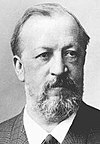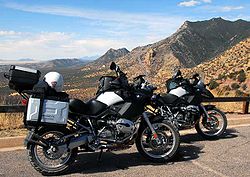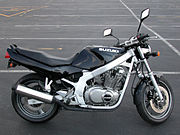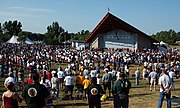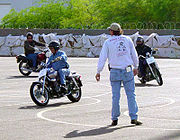Wikipedia portals: Culture · Geography · Health · History · Mathematics · Natural sciences · Philosophy · Religion · Society · Technology
In the final months of 2002, the BA model received the influential Wheels Car of the Year award, breaking a 36-year drought. The BA also won four consecutive Australia's Best Cars awards, spanning three years. (more...) Other selected articles
Report:Chinese company Geely to buy Volvo brand from Ford Motor Co.Geely will invest about $10 billion in Volvo and will produce a new vehicle with a Volvo badge in China. It also indicates the deal will only be made public when (and if, given Geely's track record of inking deals to make cars) the automakers can agree on technology transfers. Source: [1] Nicolaus OttoNicolaus August Otto (June 14, 1832 Holzhausen, Nassau -January 26, 1891 Cologne) was the German inventor of the internal-combustion engine, the first engine to burn fuel directly in a piston chamber. Up until his invention, all engines were external-combustion engines and fuel was burned in a separate compartment. In 1864, Otto co-founded an engine manufacturing business inCologne. Along with his business partner Eugen Langen he established “N.A. Otto & Cie.”. This company exists today as “Deutz AG”, who boasts the fact that they are the world's oldest engine manufacturers, with over 140 years of experience. (more...)
The Aston Martin DB9 is the car that I'd be most likely to sell my children into slavery for. If you wish to help, you can:
|
Wednesday, August 12, 2009
Motorcycle
From Wikipedia, the free encyclopedia
A motorcycle (also called a motorbicycle, motorbike, bike, or cycle) is a single-track,[1] two-wheeled[2] motor vehicle. Motorcycles vary considerably depending on the task for which they are designed, such as long distance travel, navigating congested urban traffic, cruising,sport and racing, or off-road conditions.
Motorcycles are the most affordable form of motorised transport in many parts of the world, and for most of the world's population, they are also the most common type of motor vehicle.[3][4][5] There are around 200 million motorcycles (including mopeds, motor scooters and other powered two- and three-wheelers) in use worldwide,[6] or about 33 motorcycles per 1000 people. This compares to around 590 million cars, or about 91 per 1000 people. Most of the motorcycles, 58%, are in the developing countries of Asia,[7] while 33% of the cars (195 million) are concentrated in the US and Japan. In the two countries of India and China, there are a total of 6 million cars, but 71 million motorcycles.[8][9] These numbers, particularly in the developing world, are dwarfed by the number of bicycles in use, estimated to be near twice the number of cars, worldwide.[10]
Contents[hide] |
[edit]History

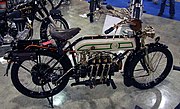
Arguably, the first motorcycle was designed and built by the German inventors Gottlieb Daimler and Wilhelm Maybach in Bad Cannstatt (since 1905 a city district of Stuttgart) in 1885.[11] The first petroleum-powered vehicle was essentially a motorised bicycle, although the inventors called their invention the Reitwagen ("riding car"). However, if a two-wheeled vehicle with steam propulsion is considered a motorcycle, then the first one may have been American. One such machine was demonstrated at fairs and circuses in the eastern U.S. in 1867, built by Sylvester Howard Roper of Roxbury, Massachusetts.[11]
In 1894, Hildebrand & Wolfmüller became the first motorcycle available for purchase.[12] In the early period of motorcycle history, many producers of bicycles adapted their designs to accommodate the new internal combustion engine. As the engines became more powerful and designs outgrew the bicycle origins, the number of motorcycle producers increased.
Until the First World War, the largest motorcycle manufacturer in the world was Indian,[13][14] producing over 20,000 bikes per year.[15] By 1920, this honour went to Harley-Davidson, with their motorcycles being sold by dealers in 67 countries.[16][17] By the late 1920s or early 1930s, DKW took over as the largest manufacturer.[18][19][20]
After the Second World War, the BSA Group became the largest producer of motorcycles in the world, producing up to 75,000 bikes per year in the 1950s.[citation needed] The German company NSU held the position of largest manufacturer from 1955 until the 1970s.[citation needed]

In the 1950s, streamlining began to play an increasing part in the development of racing motorcycles and the "dustbin fairing" held out the possibility of radical changes to motorcycle design. NSU and Moto-Guzzi were in the vanguard of this development both producing very radical designs well ahead of their time.[21] NSU produced the most advanced design, but after the deaths of four NSU riders in the 1954–1956 seasons, they abandoned further development and quit Grand Prix motorcycle racing.[22] Moto-Guzzi produced competitive race machines, and by 1957 nearly all the Grand Prix races were being won by streamlined machines.[citation needed] The following year, 1958, full enclosure fairings were banned from racing by the FIM in the light of the safety concerns.
From the 1960s through the 1990s, small two-stroke motorcycles were popular worldwide, partly as a result of East German Walter Kaaden's engine work in the 1950s.[23]
Today, the motorcycle industry is mainly dominated by Japanese companies such as Honda, Kawasaki, Suzuki, and Yamaha, although Harley-Davidson and BMW continue to be popular and supply considerable markets. Other major manufacturers include Piaggio group of Italy, KTM, Triumphand Ducati.
In addition to the large capacity motorcycles, there is a large market in smaller capacity (less than 300 cc) motorcycles, mostly concentrated in Asian and African countries. An example is the 1958 Honda Super Cub, which went on to become the biggest selling vehicle of all time. Its 60 millionth unit produced in April 2008.[24] Today, this area is dominated by mostly Indian companies with Hero Honda emerging as the world's largest manufacturer of two wheelers.[25] For example, itsSplendor model which has sold more than 8.5 million to date.[26]
[edit]Technical aspects
[edit]Construction
Motorcycle construction is the engineering, manufacturing, and assembly of components and systems for a motorcycle which results in performance, cost and aesthetics desired by the designer. With some exceptions, construction of modern mass-produced motorcycles has standardised on a steelor aluminium frame, telescopic forks holding the front wheel, and disc brakes. Some other body parts, designed for either aesthetic or performance reasons may be added. A petrol powered engine typically consisting of between one and four cylinders (and less commonly, up to eight cylinders) coupled to a manual five- or six-speed sequential transmission drives the swingarm-mounted rear wheel by a chain, driveshaft or belt.
[edit]Fuel economy
Motorcycle fuel economy varies greatly with engine displacement and riding style[27] ranging from a low of 29 mpg-US (8.1 L/100 km; 35 mpg-imp) reported by a Honda VTR1000F rider,[28] to 107 mpg-US (2.20 L/100 km; 129 mpg-imp) reported for the Verucci Nitro 50 cc Scooter.[29] A specially designed Matzu Matsuzawa Honda XL125 achieved 470 mpg-US (0.50 L/100 km; 560 mpg-imp) "on real highways - in real conditions."[30] Due to lower engine displacements (100 cc–200 cc), motorcycles in developing countries offer good fuel economy.[citation needed] In the Indian market, the second most selling company, Bajaj, offers two models with superior fuel economy: XCD 125 and Platina. Both are 125 cc motorbikes with a company-claimed fuel economy of 256 mpg-US (0.919 L/100 km; 307 mpg-imp) and 261 mpg-US (0.901 L/100 km; 313 mpg-imp), respectively.[citation needed]
[edit]Electric motorcycles
Very high fuel economy equivalents can be derived by electric motorcycles. Electric motorcycles are nearly silent, zero-emission electric motor-driven vehicles. Operating range and top speed suffer because of limitations of battery technology.[citation needed] Fuel cells and petroleum-electric hybrids are also under development to extend the range and improve performance of the electric motors.
[edit]Dynamics

Different types of motorcycles have different dynamics and these play a role in how a motorcycle performs in given conditions. For example, a shorter wheelbase would generally make a bike lean faster[citation needed] and would be quicker around corners compared to a longer wheelbase. Longer wheelbase on the other hand provides more stability in a straight line.[31] Motorcycle tyres have a large influence over handling.
Motorcycles must be leaned in order to make turns. This lean is induced by the method known as countersteering, in which the rider steers the handlebars in the direction opposite of the desired turn. Because it is counter-intuitive this practice is often very confusing to novices—and even to many experienced motorcyclists.[32]
Short wheelbase motorcycles, such as sport bikes, can generate enough torque at the rear wheel, and enough stopping force at the front wheel, to lift the opposite wheel off the pavement. These actions, if performed on purpose, are known as wheelies and stoppies respectively. If carried past the point of recovery the resulting upset is known as "looping" the vehicle.
[edit]Accessories
Various features and accessories may be attached to a motorcycle either as OEM (factory-fitted) or after-market. Such accessories are selected by the owner to enhance the motorcycle's appearance, safety, performance, or comfort, and may include anything from mobile electronics to sidecars and trailers.
[edit]Social aspects
[edit]Popularity
In many cultures, motorcycles are the primary means of motorised transport. According to the Taiwanese government, for example, "the number of automobiles per ten thousand population is around 2,500, and the number of motorcycles is about 5,000."[33] In places such as Vietnam, motorcycle use is extremely high due to a lack of public transport and low income levels that put automobiles out of reach for many.[3] In Vietnam, motorised traffic consist of mostly motorbikes.[4] The four largest motorcycle markets in the world are all in Asia: China, India, Indonesia, and Vietnam.[3] The motorcycle is also popular in Brazil's frontier towns.[5] Amid the global economic downturn of 2008, the motorcycle market grew by 6.5%.[34]
Recent years have seen an increase in the popularity of motorcycles elsewhere. In the USA, registrations increased by 51% between 2000 and 2005.[35] This is mainly attributed to increasing fuel prices and urban congestion,[36] but is also partly due to television programmes such as reality show American Chopper, or adventure-travel shows such as Long Way Down.[citation needed]
[edit]Subcultures

Around the world, motorcycles have historically been associated with subcultures. Some of these subcultures have been loose-knit social groups such as the cafe racers of 1950s Britain, and the Mods and Rockers of the 1960s. A few are believed to be criminal gangs.
Social motorcyclist organisations are popular and are sometimes organised geographically, focus on individual makes, or even specific models. Example motorcycle clubs include: American Motorcyclist Association, Harley Owners Group and BMW MOA. Some organisations hold large international motorcycle rallies in different parts of the world that are attended by many thousands of riders.
Whereas many social motorcycle organisations raise money for charities through organised events and rides, some other motorcycle organisations exist only for the direct benefit of others. Bikers Against Child Abuse (BACA) is one example. BACA assigns members to individual children to help them through difficult situations, or even stay with the child if the child is alone or frightened.[37]
In recent decades, motorcyclists have formed political lobbying organisations in order to influence legislators to introduce motorcycle-friendly legislation. One of the oldest such organisations, the British Motorcycle Action Group, was founded in 1973 specifically in response to helmet compulsion, introduced without public consultation.[38] In addition, the British Motorcyclists Federation (BMF), originally founded in 1960 as a reaction to the public perception of motorcyclists as leather-jacketed hooligans, has itself moved into political lobbying. Likewise, the U.S. has ABATE, which, like most such organisations, also works to improve motorcycle safety, as well as running the usual charity fund-raising events and rallies, often for motorcycle-related political interests.[39]
At the other end of the spectrum from the charitable organizations and the motorcycle rights activists are the Outlaw Motorcycle Gangs. These are defined by the Provincial Court of Manitoba as: "Any group of motorcycle enthusiasts who have voluntarily made a commitment to band together and abide by their organizations' rigorous rules enforced by violence, who engage in activities that bring them and their club into serious conflict with society and the law".[40] The Federal Bureau of Investigation (FBI) and Criminal Intelligence Service Canada have designated four MCs as Outlaw Motorcycle Gangs (OMGs), which are the Pagans, Hells Angels, Outlaws MC, and Bandidos,[41][42] known as the "Big Four".[43]
[edit]Mobility
While people choose to ride motorcycles for various reasons, those reasons are increasingly practical, with riders opting for a powered two-wheeler as a cost-efficient alternative to infrequent and expensive public transport systems, or as a means of avoiding or reducing the effects of urban congestion.[45] In places where it is permitted, lane splitting, also known as filtering, allows motorcycles to use the space between vehicles to move through stationary or slow traffic.[46]
In the UK, motorcycles are exempt from the £8 per day London congestion charge other vehicles must pay to enter the city during the day. Motorcycles are also exempt from toll charges at some river crossings, such as the Severn Bridge, Dartford Crossing, and Mersey Tunnels. Some cities, such as Bristol, allow motorcycles to use bus lanes and provide dedicated free parking. In the United States, those states that have high-occupancy vehicle lanes also allow for motorcycle travel in them. Other countries have similar policies.
In New Zealand motorcycle riders are not required to pay for parking that is controlled by a barrier arm;[47] the arm does not occupy the entire width of the lane, and the motorcyclist simply rides around it.[48] Many car parks controlled in this way supply special areas for motorcycles to park, so as not to unnecessarily consume spaces.
[edit]Safety
Motorcycles have a higher rate of fatal accidents than automobiles. United States Department of Transportation data for 2005 from the Fatality Analysis Reporting System show that for passenger cars, 18.62 fatal crashes occur per 100,000 registered vehicles. For motorcycles this figure is higher at 75.19 per 100,000 registered vehicles – four times higher than for cars.[49] The same data show that 1.56 fatalities occur per 100 million vehicle miles travelled for passenger cars, whereas for motorcycles the figure is 43.47 – 28 times higher than for cars. Furthermore for motorcycles the accident rates have increased significantly since the end of the 1990s, while the rates have dropped for passenger cars.
The two major causes of motorcycle accidents in the United States are: motorists pulling out or turning in front of motorcyclists and violating their rights-of-way and motorcyclists running wide through turns. The former is sometimes called a SMIDSY, an acronym formed from the motorists' common response of "Sorry mate, I didn't see you".[50] The latter is more common when motorcyclists mix drinking with riding.[51] Motorcyclists can anticipate and avoid some of these crashes with proper training, increasing their conspicuousness to other traffic, and separating alcohol and riding.
The United Kingdom has several organisations which are dedicated to improving motorcycle safety by providing advanced rider training over and above what is necessary to pass the basic motorcycle test. These include the Institute of Advanced Motorists (IAM) and the Royal Society for the Prevention of Accidents (RoSPA). Along with increased personal safety, riders with these advanced qualifications often benefit from reduced insurance costs.
Motorcycle Safety Education is offered throughout the United States by organisations ranging from state agencies to non-profit organisations to corporations. The courses, designed by the Motorcycle Safety Foundation (MSF), include a Basic Rider Course, an Intermediate Rider Course and an Advanced Rider Course.
In the UK (except Northern Ireland) and some Australian jurisdictions, such as New South Wales,[52] the Australian Capital Territory,[53] Tasmania[54] and the Northern Territory,[55] it is compulsory to undertake a rider training course before being issued a Learners Licence.
In Canada, motorcycle rider training is compulsory in Quebec and Manitoba only, but all provinces and territories have Graduated Licensing programs which place restrictions on new drivers until they have gained experience. Eligibility for a full motorcycle licence or endorsement for completing a Motorcycle Safety course varies by province. The Canada Safety Council, a non-profit safety organisation, offers the Gearing Up program across Canada and is endorsed by the Motorcycle and Moped Industry Council.[56] Training course graduates may qualify for reduced insurance premiums.
[edit]Types
There are three major types of motorcycle: street, off-road, and dual purpose. Within these types, there are many different sub-types of motorcycles for many different purposes.
Street bikes include cruisers, sportbikes, scooters and mopeds, and many other types. Off-road motorcycles include many types designed for dirt-oriented racing classes such as motocross and are not street legal in most areas. Dual purpose machines like the dual-sport style are made to go off-road but include features to make them legal and comfortable on the street as well.
Each configuration offers either specialised advantage or broad capability, and each design creates a different riding posture.
[edit]Motorcycle rider postures
The motorcyclist's riding position depends on rider body-geometry (anthropometry) combined with the geometry of the motorcycle itself. These factors create a set of three basic postures.[57]
- Sport — the rider leans forwards into the wind and the weight of the upper torso is supported by air pressure as long as the motorcycle is travelling at speed, typically above 50 mph (80 km/h). The footpegs are below the rider or to the rear. The reduced frontal area cuts wind resistance and allow higher speeds. However, at low-speed this position throws the weight of the rider onto the arms instead, and this is quickly tiring to the wrists of unfamiliar riders. Moreover, the sports position makes it more difficult for the rider to look around and foot through traffic. Many sport bikes have narrow, swept-back handlebars, or clip-ons (short stubs clamped to the telescopic fork tubes). Following the style of racing bikes, most have full-fairings and often come with almost complete engine enclosure, although motorcycles with a sport riding position are becoming more diverse with the marketing of factory naked bikes,streetfighters, retro cafe racers, and other blends of styles, having varying riding positions somewhere in the range from sport to standard.[58]
- Standard — the rider sits upright or leans forwards slightly. The feet are below the rider, not too far to the front or back. These are straightforward, versatile motorcycles that are not too specialized for one task, but don't excel in one area either.[59] Standards are used in touring, commuting, and sporting, and are good for beginners.[58] The rider enjoys the benefits of freedom of head movement, good visibility in all directions, and easier use of the feet while moving through stationary traffic.
- Cruiser — the rider sits at a lower seat height with the upper torso upright or leaning slightly rearwards. Legs are extended forwards, sometimes out of reach of the regular controls on cruiser pegs. The low seat heights can be a consideration for new or short riders. Handlebars tend to be high, and wide. Harley-Davidsons are exemplars of this style.[60] The emphasis is on comfort, while compromising cornering ability because of low ground clearance and the greater likelihood of scraping foot pegs, floor boards, or other parts if turns are taken at the speeds other types of motorcycles can do.[61][62]
Important factors of a motorcycle's ergonomic geometry that determine the seating posture include the height, angle and location of footpegs, seat and handlebars. Likewise, factors in a rider's physical geometry that contribute to seating posture include torso, arm, thigh and leg length, and overall rider height.
[edit]Legal definitions and restrictions
A motorcycle is broadly defined by law in most countries for the purposes of registration, taxation and rider licensing as a powered two-wheel motor vehicle. Most countries distinguish between mopeds of 49 cc and the more powerful, larger, vehicles (scooters do not count as a separate category). Many jurisdictions include some forms of three-wheelers as motorcycles.
[edit]Australia and New Zealand
In New Zealand, "learner" and "restricted" motorcycles may only have a 250 cc engine capacity, restricting 15-year-old learner riders to speeds of around, or a bit more than, 160 km/h (99 mph).
- Note that on a learner licence on a motorcycle limits the rider to riding up to 70 km/h (maximum of 80 km/h in NSW, Australia), anything over this figure would be breaking the law.
The legal age to be eligible to apply for a New Zealand motorcycle licence is 15 years and over. New Zealand employs a three stage system for motor vehicle licensing. At age 15, an individual can gain their first licence known as their "learner licence". They must hold this for at least 6 months before they are able to move on to their "restricted licence". They must then hold this restricted licence for one and half years. After a period of 6–18 months, depending on age and additional training, a holder of a restricted licence may sit the third and final stage known as the "full licence". Until an individual has their full licence they are only able to ride a motorcycle which has an engine capacity of 250 cc or less.[63]
A similar system is used in most states of Australia, with some variations. "Learners Permit" and "Provisional" licence holders must not have bikes that exceed a power to weight ratio of 150 kW/tonne or 660 cc, whichever comes first. All 250 cc bikes (with a few listed exceptions) are automatically included in this LAMS (Learner Approved Motorcycle Scheme) list.
Before getting a learners permit a pre-learner course is required, which issues a certificate of completion, valid for 3 months. Upon passing a computer test, the rider is granted a learners permit, which is valid for 12 months. Whilst on a learners permit, the rider may not carry a pillion or side car and may not exceed 80 kilometres per hour (50 mph) or the posted speed limit, whichever is lower, in certain jurisdictions.[64]
To progress to a provisional licence, the rider must successfully complete a pre-provisional riders course, followed by a riding skills test called MOST (Motorcycle Operator Skill Test). The rider is then able to obtain a P1 provisional licence. These licences can be renewed and must be held without suspension for 12 months, after which time it can be upgraded to a P2 provisional licence, which is then to be held for 2 more years before the rider obtains their full licence, providing they have not breached any laws causing them to be suspended or disqualified in that period. P2 provisional riders are permitted to carry a pillion, P1 riders are not. There are exceptions to this rule for mature age licence holders, who may be eligible to bypass the P2 provisional period.[64]
The laws of some countries allow anyone with a car licence to legally ride mopeds not exceeding 50 cc in capacity, meaning that they do not need to show any competency in handling such a vehicle.
[edit]Canada and the US

In Canada and the United States[65] three-wheeled motor vehicles fall under the auspices of motorcycle regulations. The laws and regulations for legal moped usage in the U.S. vary by state.[66]
In the United States, licensing requirements vary widely among the states and territories, but generally riders are required to pass written and practical (on-cycle) competency tests. In about half the states, successful completion of a rider education course (such as those offered by the Motorcycle Safety Foundation) is accepted by state licensing agencies in lieu of examination. The specifics of the motorcycle and moped laws in the U.S. can be obtained from each individual state's Department of Motor Vehicles website.[67]
[edit]United Kingdom
Motorcycle riders in the UK must normally take a one-day Compulsory Basic Training (CBT) course, regardless of which class of motorcycle they intend to ride.[68] In addition a theory test must be taken prior to taking a practical test for any type of motorcycle licence.
Entry level to motorcycling at age 16 is the moped, a motorcycle of engine capacity no greater than 50 cc restricted to a maximum design speed of 50 km/h (31 mph).[68]
At age 17 the rider may have a "light motorcycle" with an engine up to 125 cc and a power output not exceeding 11 kW (15 hp). Only a CBT certificate, obtained within the past two years, and a provisional licence is needed to ride a learner motorcycle with an L plate. After passing a test on a 125 cc machine, riders will be restricted to ride a "large restricted motorcycle", which has a maximum power output of 25 kW (34 hp). After two years this restriction is lifted and any size or power of motorcycle may be ridden.[68]
For riders over age 21 there is a direct access route to gaining a licence to ride a "large motorcycle" of any engine capacity or power,[68] which allows somebody with no motorcycle experience to train and pass a test in around five days.
Three-wheeled vehicles weighing less than 8 cwt (896 lb / 406 kg were long classified as motorcycles in the UK and could be driven with a full motorcycle licence (a requirement there be no reverse gear fitted was dropped in the 1960s). This exemption was linked to the enduring popularity of three-wheeled vehicles in the UK (such as the Reliant Regal van) but was abolished for new licence holders in October 2000.[69] Mass-production of three-wheelers ceased in 1998 but the licensing exemption still benefits trikes and their riders.
[edit]Environmental impact
In 2007 and 2008, motorcycles and scooters, due to good fuel efficiency, attracted interest in the United States from environmentalists and those affected by increased fuel prices.[70][71]Piaggio Group Americas supported this interest with the launch of a "Vespanomics" website and platform, citing lower per-mile carbon emissions (40 lb/mile less than the average car, a 65% reduction) and better fuel economy.[72]
Other sources, however, claim that while motorcycles produce much less pollution in terms of greenhouse gases, a motorcycle can in some cases emit 10–20 times the quantity of nitrogen oxides (NOx) when compared to the NOx emissions of a car.[70][73] This is because many motorcycles lack a catalytic converter to reduce NOx emissions, and whilst catalytic converters have been used in cars long enough that they are now commonplace, they are a relatively new technology in motorcycles.[70] However, it should be noted that many newer motorcycles (such as later models of the Yamaha R1 and Suzuki GSXR1000) now have factory fitted catalytic converters. Along with other technologies that have taken longer to appear in motorcycles (e.g. fuel injection, anti-lock brake systems),[citation needed] catalytic converters are becoming increasingly commonplace.
United States Environmental Protection Agency 2007 certification result reports for all vehicles versus on highway motorcycles (which also includes scooters),[74] the average certified emissions level for 12,327 vehicles tested was 0.734. The average "Nox+Co End-Of-Useful-Life-Emissions" for 3,863 motorcycles tested was 0.8531, for a difference of about 16%, not the claimed 10X factor. Likewise, if one looks at how many of the 2007 motorcycles tested were also catalytic equipped, 54% of them, 2,092, were equipped with a catalytic converter.
[edit]United States emissions limits
The following table shows maximum acceptable legal emissions of the combination of hydrocarbon and nitrous oxides, as well as carbon monoxide, for new Class III motorcycles (280 cc or larger displacement) sold in the United States.[75]
| Tier | Model Year | HC+NOx (g/km) | CO (g/km) |
|---|---|---|---|
| Tier 1 | 2006–2009 | 1.4 | 12.0 |
| Tier 2 | 2010 and later | 0.8 | 12.0 |
The maximum acceptable legal emissions of hydrocarbon and carbon monoxide for new Class I and II motorcycles (50 cc–169 cc and 170 cc–279 cc respectively) sold in the United States are as follows:[75]
| Model year | HC (g/km) | CO (g/km) |
|---|---|---|
| 2006 and later | 1.0 | 12.0 |
[edit]Europe
European emission standards for motorcycles are similar to those for cars. Motorcycles must meet Euro III standards,[76] while cars must meet Euro IV standards. Therefore, the difference in total pollution between motorcycles and cars that pass European emission standards would be small, certainly much smaller than the 10X factor claimed by the referenced LA Timesarticle.
[edit]See also
- List of motorcycle manufacturers
- Fédération Internationale de Motocyclisme (FIM) - the governing body for international motorcycle sport, which also lobbies for the rights and interests of motorcyclists.
[edit]References
- ^ Foale, Tony (2006). Motorcycle Handling and Chassis Design. Tony Foale Designs. p. 4-1. ISBN 978-84-933286-3-4.
- ^ Cossalter, Vittore (2006). Motorcycle Dynamics. Lulu. ISBN 978-1-4303-0861-4.
- ^ a b c Hiroko Nakata (2008-10-08). "Motorcycle makers battle it out in Vietnam". Japan Times. Retrieved on 2009-03-11.
- ^ a b Patti McCracken (2008-10-01). "Vietnam eats, sleeps, and dreams on motorbikes". The Christian Science Monitor. Retrieved on 2009-03-11.
- ^ a b Alexei Barrionuevo (2008-11-03). "That Roar in the Jungle Is 15,000 Motorbikes". The New York Times. Retrieved on 2009-03-11.
- ^ "Fuel Cell Powered Motorcycles", Journal of the Society of Automotive Engineers of Japan 60 (1): 90-93, 2006, ISSN 0385-7298
- ^ That is, Southern and Eastern Asia, and the Asia Pacific countries, excluding Japan.
- ^ "Passenger Cars; Map No. 31", Worldmapper: The world as you've never seen it before, 2002 See Technical notes for this data
- ^ "Mopeds And Motorcycles Map No. 32", Worldmapper: The world as you've never seen it before, 2002 See Technical notes for this data
- ^ "One billion bicycles", Did you know?
- ^ a b "The Past—1800s: First motorcycle". The History and Future of Motorcycles and motorcycling—From 1885 to the Future, Total Motorcycle Website. Retrieved on 2007-06-28.
- ^ "Brief History of the Marque: Hildebrand & Wolfmuller". Hildebrand & Wolfmuller Motorad, European Motorcycle Universe. Retrieved on 2007-06-28.
- ^ Walker, Mick (2006), Motorcycle: Evolution, Design, Passion, JHU Press, ISBN 0801885302, 9780801885303
- ^ George Hendee, The AMA Motorcycle Hall of Fame Museum, retrieved on 2009-08-08
- ^ Youngblood, Ed (June 2001), "The Rise and Fall", American Motorcyclist (American Motorcyclist Assoc) 55 (0277-9358)
- ^ Prashad, Sharda (Apr 16, 2006), "HOG WILD; U of T professor Brendan Calder is one of the legions of baby boomers who have helped to ensure the success of the Harley- Davidson brand name, not to mention its bottom line.", Toronto Star (Toronto, Ont.): A.16
- ^ Cato, Jeremy (August 8, 2003), "Harley-Davidson at 100", The Vancouver Sun (Vancouver, B.C.): E.1.Fro
- ^ Vance, Bill (April 24, 2009), "Motoring Memories: DKW/Auto Union, 1928 - 1966", Canadian Driver
- ^ de Cet, Mirco (2002), The illustrated directory of motorcycles, MotorBooks/MBI Publishing Company, p. 128, ISBN 0760314179, 9780760314173
- ^ Walker, Mick (1999), Mick Walker's German Racing Motorcycles, Redline Books, p. 61, ISBN 0953131122, 9780953131129
- ^ Willoughby, Vic (1982). Exotic Motorcycles. London: Osprey Publishing, Ltd. ISBN 0850453224.
- ^ "Rupert Hollaus". Motorsport Memorial. Retrieved on 2008-04-03.
- ^ Ed Youngblood. "Motocross goes International, 1947 through 1965". The History of Motocross, Part Two, Motorcycle Hall of Fame Museum. Retrieved on 2007-06-29.
- ^ Honda Sells Its 60 Millionth - Yes, Millionth - Super Cub Wired.com
- ^ World's Cheapest Car -By Forbes
- ^ "Hero Honda splendor sells more than 8.5 million units". indiacar.net. Retrieved on 2008-08-10.
- ^ "Motorcycle Fuel Consumption & Real World Performance Guide". MFC Website. Retrieved on 2008-06-13.
- ^ "Total Motorcycle Fuel Economy Guide". Total Motorcycle Website. Retrieved on 2006-08-14.
- ^ "Verucci Gas Scooters". Gekgo Worldwide, www.gekgo.com. Retrieved on 2006-08-15.
- ^ "Doing More with Less Energy". The Craig Vetter Fuel Economy Contests - 1980 through 1985. Retrieved on 2006-08-15.
- ^ Gaetano, Cocco (2004). Motorcycle Design and Technology. Minneapolis: MotorBooks/MBI Publishing Company. pp. 34–35.
- ^ Joel Fajans (July 2000). "Steering in bicycles and motorcycles" (PDF). American Journal of Physics, v. 68 (7): 654–59. Retrieved on 2006-08-04.
- ^ Chung-Li. "Sustainable Development Indicators for Taiwan". Workshop on Sustainable Development Indicators. Retrieved on 2006-08-14.
- ^ Makiko Kitamura and Tetsuya Komatsu (2009-03-03). "Honda’s $140-a-Month Motorbikes Ease Pain of ‘Grim’ Car Market". Bloomberg. Retrieved on 2009-03-11.
- ^ "Popularity of high-performance motorcycles helps push rider deaths to near-record high". Insurance Institute for Highway Safety. 11 September 2007. Retrieved on 2008-10-22.
- ^ "Soaring Gas Prices Shine Money-Saving Spotlight on Motorcycles". Reuters. 19 May 2008. Retrieved on 2008-10-22.
- ^ "About BACA". Bikers Against Child Abuse. Retrieved on 2007-10-10.
- ^ "About MAG". MAG UK. Retrieved on 2007-10-10.
- ^ Some other lobbying organisations are listed in Category:Motorcyclists organizations.
- ^ Organized Crime Fact Sheet- Public Safety Canada
- ^ FBI Safe Street Violent Crime Initiative - Report Fiscal Year 2000- FBI.org
- ^ 2004 Annual Report- Criminal Intelligence Service Canada, cisc.gc.ca
- ^ Motorcycle Gangs- Connecticut Gang Investigators Association
- ^ http://www.automobileindia.com/two-wheelers/statistics/sales.html
- ^ Bob Tomlins (September 1997). "Rider training in Europe The Views and the Needs of the Rider" (PDF). The Federation of European Motorcyclists. Retrieved on 2007-06-30.
- ^ "All the info you need on lanesharing (lanesplitting)". www.WhyBike.com. Retrieved on 2007-06-28.
- ^ "Parking Drivers guide to Auckland City parking". City of Aukland. 2007. Retrieved on 2008-08-08.
- ^ Motorcycle parking in Wellington CBD [Archive] - Kiwi Biker forums
- ^ "Vehicles Involved in Fatal Crashes, 1994–2006 - State: USA". Fatality Analysis Reporting System. United States Department of Transportation. Retrieved on 2007-11-12.
- ^ "The 'sorry mate I didn't see you' campaign". South Gloucestershire Council. Retrieved on 2008-05-21.
- ^ Hurt, H.H., Ouellet, J.V. and Thom, D.R. (January 1981). "The Hurt Report". Technical Report, Volume 1, Traffic Safety Center, University of Southern California. Retrieved on 2007-05-16.
- ^ "Learner riders licence". Motorcycle Rider Training Scheme, Roads and Traffic Authority, NSW. Retrieved on 2007-05-16.
- ^ "Learner Licence". Road Transport Information Management, www.rego.act.gov.au. Retrieved on 2007-05-16.
- ^ "TAS Learner Licence". Department of Infrastructure, Energy and Resources, http://www.transport.tas.gov.au. Retrieved on 2009-06-13.
- ^ "Motorcyclist Education Training And Licencing (METAL)". Northern Territory Department of Planning and Infrastructure, www.ipe.nt.gov.au. Retrieved on 2007-05-16.
- ^ "MMIC Information". Motorcycle and Moped Industry Council. Retrieved on 2007-05-16.
- ^ "A Three Dimensional Analysis of Riding Posture in Three Different Styles of Motorcycle" (PDF). Motorcycle Safety Foundation. March 2006. Retrieved on 2008-01-31.
- ^ a b Stermer, Bill (2006), Streetbikes: Everything You Need to Know, MotorBooks/MBI Publishing Company, p. 16, ISBN 0760323623, 9780760323625
- ^ Duglin Kennedy, Shirley (2005), The Savvy Guide to Motorcycles, Indy Tech Publishing, p. 75, ISBN 0790613166, 9780790613161
- ^ Seeley, Alan (2004), The Motorcycle Book: Everything You Need to Know about Owning, Enjoying, and Maintaining Your Bike, MotorBooks/MBI Publishing Company, pp. 18-19, ISBN 0760317453, 9780760317457
- ^ Stermer, Bill (2006), Streetbikes: Everything You Need to Know, MotorBooks/MBI Publishing Company, p. 10, ISBN 0760323623, 9780760323625
- ^ Duglin Kennedy, Shirley (2005), The Savvy Guide to Motorcycles, Indy Tech Publishing, p. 71, ISBN 0790613166, 9780790613161
- ^ "Getting your motorcycle licence". Land Transport New Zealand. Retrieved on 2008-03-05.
- ^ a b "Motorcycle". Rta.nsw.gov.au. Retrieved on 2008-10-24.
- ^ NHTSA defines the term “motorcycle,” for the purpose of the statute and regulations it administers, as “a motor vehicle with motive power having a seat or saddle for the use of the rider and designed to travel on not more than three wheels in contact with ground” (49 CFR 571.3)
- ^ "Moped Laws". www.mopedarmy.com. Retrieved on 2007-05-16.
- ^ "DMV Websites". www.mopedarmy.com. Retrieved on 2007-05-16.
- ^ a b c d "Mopeds and Motorcycles: Routes to your licence" (PDF). UK Department for Transport. Retrieved on 3 July 2009.
- ^ Trike Law The Trike Shop UK.
- ^ a b c Susan Carpenter (June 11, 2008). "Motorcycles and emissions: The surprising facts". LA Times. Retrieved on 2008-08-08.
- ^ Judy Dahl (September 2007). "Baby, You Can Drive My Vespa". Madison Magazine. Retrieved on 2008-08-08.
- ^ "Vespanomics - Vespa Economics". Piaggio Group USA. Retrieved on 2009-01-09.
- ^ Umbra Fisk (28 May 2003). "On motorcycles - Ask Umbra". Grist.
- ^ "Certified Highway Motorcycle Test Result Report Data (2007)". US EPA. 8 January 2008.
- ^ a b "EPA Emissions Regulations for 1978 and Later New Motorcycles, General Provisions". United States Environmental Protection Agency. Retrieved on 2009-06-01.
- ^ "Motorcycle Emissions Regs Examined". Motorcycle USA.




